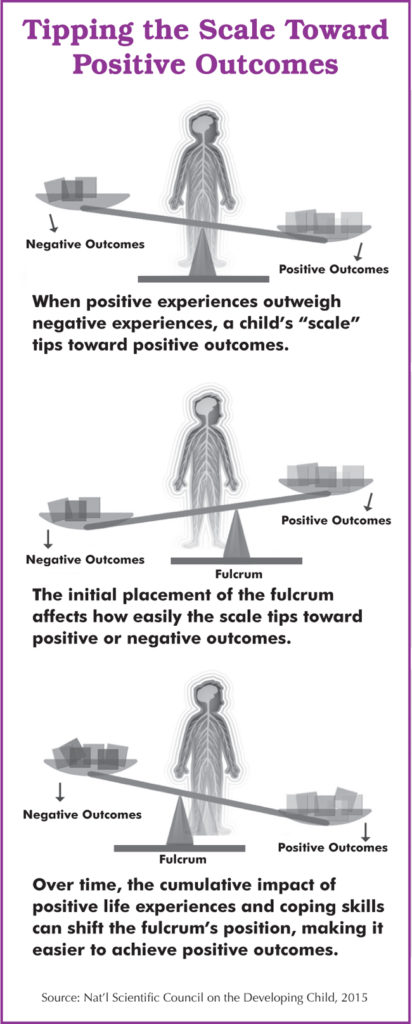One way to understand the development of resilience is to visualize a balance scale or seesaw (see figure below). Protective experiences and coping skills on one side counterbalance significant adversity on the other. Resilience is evident when a child’s health and development tips toward positive outcomes—even when a heavy load of factors is stacked on the negative outcome side.
1. The single most common factor for children who develop resilience is at least one stable and committed relationship with a supportive parent, caregiver, or other adult. These relationships provide the personalized responsiveness, scaffolding, and protection that buffer children from developmental disruption. They also build key capacities—such as the ability to plan, monitor, and regulate behavior—that enable children to respond adaptively to adversity and thrive. This combination of supportive relationships, adaptive skill-building, and positive experiences is the foundation of resilience.
 2. Children who do well in the face of serious hardship typically have a biological resistance to adversity and strong relationships with the important adults in their family and community. Resilience is the result of a combination of protective factors. Neither individual characteristics nor social environments alone are likely to ensure positive outcomes for children who experience prolonged periods of toxic stress. It is the interaction between biology and environment that builds a child’s ability to cope with adversity and overcome threats to healthy development.
2. Children who do well in the face of serious hardship typically have a biological resistance to adversity and strong relationships with the important adults in their family and community. Resilience is the result of a combination of protective factors. Neither individual characteristics nor social environments alone are likely to ensure positive outcomes for children who experience prolonged periods of toxic stress. It is the interaction between biology and environment that builds a child’s ability to cope with adversity and overcome threats to healthy development.
3. Research has identified a common set of factors that predispose children to positive outcomes in the face of significant adversity. Individuals who demonstrate resilience in response to one form of adversity may not necessarily do so in response to another. Yet when these positive influences are operating effectively, they “stack the scale” with positive weight and optimize resilience across multiple contexts. These counterbalancing factors include:
- facilitating supportive adult-child relationships;
- building a sense of self-efficacy and perceived control;
- providing opportunities to strengthen adaptive skills and self-regulatory capacities; and
- mobilizing sources of faith, hope, and cultural traditions.
4. Learning to cope with manageable threats is critical for the development of resilience. Not all stress is harmful. There are numerous opportunities in every child’s life to experience manageable stress—and with the help of supportive adults, this “positive stress” can be growth-promoting. Over time, we become better able to cope with life’s obstacles and hardships, both physically and mentally.
5. The capabilities that underlie resilience can be strengthened at any age. The brain and other biological systems are most adaptable early in life. Yet while their development lays the foundation for a wide range of resilient behaviors, it is never too late to build resilience. Age-appropriate, health-promoting activities can significantly improve the odds that an individual will recover from stress-inducing experiences.
For example, regular physical exercise, stress-reduction practices, and programs that actively build executive function and self-regulation skills can improve the abilities of children and adults to cope with, adapt to, and even prevent adversity in their lives. Adults who strengthen these skills in themselves can better model healthy behaviors for their children, thereby improving the resilience of the next generation.
Reprinted with permission from the Center on the Developing Child at Harvard University (https://developingchild.harvard.edu)
* * * *
Learn More about Resilience
The Center on the Developing Child at Harvard University has made the following available to those who want to learn more about resilience:
Watch a series of short videos that provides an overview of why resilience matters, how it develops, and how to strengthen it in children.
Read a working paper called “Supportive Relationships and Active Skill-Building Strengthen the Foundations of Resilience” by the National Scientific Council on the Developing Child.
Play the interactive “Tipping the Scales: The Resilience Game,” which teaches how the choices we make can help children and the community as a whole become more resilient in the face of serious challenges.


